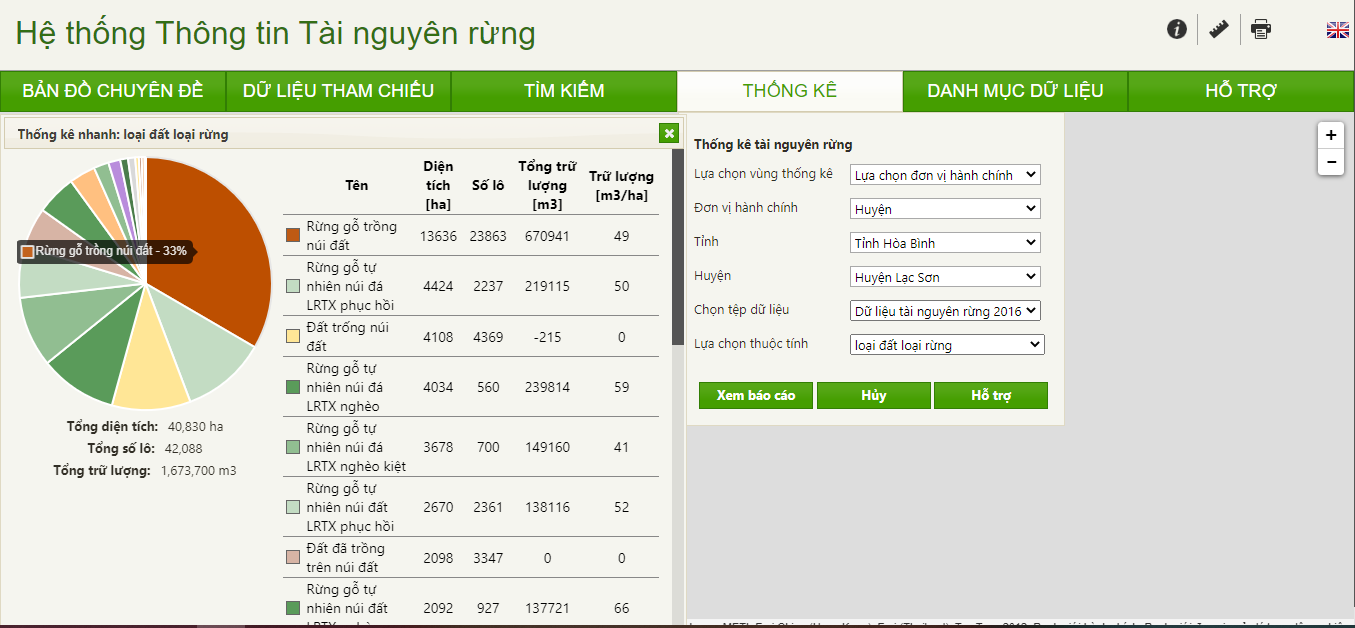Content with Safeguard A A1.1. .
FDS 2006-2020:
- To establish, manage, protect, develop and sustainably use 16.24 million ha of land planned for forestry;
- To ensure the wider participation of various economic sectors and social organisations in forestry development in order to increase their contribution to socio-economic development, protection of the ecological environment, conservation of biodiversity, provision of ecosystem services, reducing poverty and improving living standards for rural people in mountainous areas and contributing to national defence and security.
FDS 2021-2030:
- To build the forestry truly into an economic - technical sector; establish, manage, protect, develop and sustainably use of forest and land areas having been planned for forestry;
- To ensure the extensive and equal participation of all economic sectors in forestry activities, maximally mobilise all society’s resources for forestry, apply advanced and modern science and technology in forestry development;
- To maximise the potentials, roles and values of forests so that the contribution of forestry can be increasingly significant to the socio-economic development, environmental and ecological protection, insurance of water security, mitigation of natural disasters, proactive and effective response to climate change, conservation of natural resources and biodiversity, provision of diverse forest ecosystem services, creation of jobs and incomes for people, maintaining national defence and security and successfully implementing national goals for sustainable development;
- To make the State administration system for forestry streamlined, efficient and effective.
FPDP 2011-2020:
* To properly protect existing forest areas; to effectively and sustainably use forest resources and planned forestry land;
* To raise forest cover to 42-43% by 2015 and 44-45% by 2020; to increase forest yield, quality and value; to restructure the forestry sector toward raising its added value; to basically meet domestic and export demands for timber and forest products;
* To generate more jobs and raise incomes for people whose lives depend on forestry, contributing to eradicating hunger, reducing poverty and maintaining security and defence.
NTP 2016-2020:
- To improve the productivity, quality and value of each type of forest, increasing the value of production forest per area unit; to contribute fulfilling the requirements for disaster mitigation, protection of the ecological environment, and responding to climate change and sea level rise; to create jobs, raise incomes, and support hunger eradication and poverty reduction, improving the livelihoods of people earning a living from forests in association with the process of building new rural areas, ensuring security, defence, order and social security;
- To increase the value of forestry production from 5.5% to 6% per year, reach national forest cover of 42%, and increase the value of timber and forest exports to US$8-8.5 billion, maintaining 25 million jobs.
Program 2021-2025:
- Protection and sustainable development of the entire existing forest area and newly created forest area in the period of 2021 - 2025; contribute to maintaining a stable national forest coverage rate of about 42%; continue to improve the productivity and quality of forests, meet the requirements of supplying raw materials for production and consumption, protect and protect the environment, conserve biodiversity, minimise negative impacts caused by natural disasters. ear, enhancing the ability to adapt to climate change;
- The growth rate of forestry production value is 5.0 - 5.5%/year. The export value of wood and non-timber forest products will reach about 20 billion USD by 2025, of which the export value of non-timber forest products will reach over 1.5 billion USD, increasing the proportion of deep processing and export of wood products. and high value added forest products;
- Contributing to creating jobs and increasing incomes for people participating in forest protection and development activities. By 2025, income from planted production forests will increase by an average of 1.5 times/unit area compared to 2020.
The overall goal of the National REDD+ Programme is to: Contribute to protecting and improving the quality of the existing natural forests, expanding the forest area and improving the quality of plantation forests; linking with the implementation of national goals of reducing greenhouse gas emissions, forest protection and development, green growth; mobilising international support, getting access to carbon markets; and improving people's lives and the country's sustainable development.
The National REDD+ Programme’s specific objectives are:
For the period 2017-2020:
- Contribute to reducing greenhouse gas emissions through REDD+ activities; expand the forest cover to 42% and reach 14.4 million hectares of forest by 2020;
- Meet the requirements of REDD+ readiness, ensuring there is capacity to access financial resources for results-based payments as per international requirements;
- Improve the quality of natural forests and planted forests to increase carbon stock and environmental forest services; replicate effective models of forest plantation; sustainable management, protection and conservation of natural forests;
- Contribute to improve forest governance, create jobs, improve the living conditions of the people associated with the New Rural Programme and ensure security and national defence.
For the period 2021-2030:
- Stabilise the natural forest area by 2030 at least at the same level as 2020, and increase forest cover up to 45% of national territory, contributing to realise the national target of reducing total greenhouse gas emissions by 8% by 2030 compared with business as usual (BAU) scenario as committed in the Paris Agreement on climate change. This contribution may increase to 25% if receiving international support;
- Replicate highly effective models on REDD+ and sustainable forest management, integrate fully REDD+ into sustainable forestry development programmes;
- Complete policies, laws and action framework of the REDD+ programme and access financial resources for results-based payments in accordance with international requirements.
Map of Vietnam's forest status [This is pilot post_ENG]
 Map of Vietnam's forest status as of December 31, 2019 [1]
Map of Vietnam's forest status as of December 31, 2019 [1]
The Ministry of Agriculture and Rural Development has just announced the current state of national forests in 2019. Accordingly, as of December 31, 2019, the national forest area is 14,609,220 hectares.


The Ministry of Agriculture and Rural Development has just announced the current state of national forests in 2019. Accordingly, as of December 31, 2019, the national forest area is 14,609,220 hectares; in which, natural forest is 10,292,434 ha; planted forest is 4,316,786 ha.
The area of forest land eligible to calculate the national coverage rate is 13,864,223 ha, the coverage rate is 41.89%.
Thus, the area of forested land nationwide increased by 117,925 hectares compared to the national announcement of forest status in 2018; forest cover rate increased by 0.24%.
Source: VNFOREST

